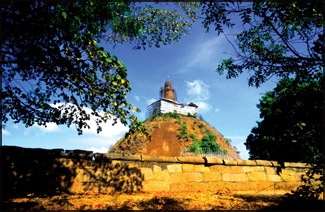|
Abhayagiri Vihara:
An international institution
 Anuradhapura,
one of the most sacred pilgrimage cities in our country, was a great
monastic centre as well as a royal capital, with magnificent monasteries
rising to many storeys, all roofed with tiles of bronze or burnt clay,
glossy in brilliant colours. Anuradhapura,
one of the most sacred pilgrimage cities in our country, was a great
monastic centre as well as a royal capital, with magnificent monasteries
rising to many storeys, all roofed with tiles of bronze or burnt clay,
glossy in brilliant colours.
To the north of the city, bordered by great walls and containing
detailed bathing ponds, carved handrails and moonstones, stood
Abhayagiri, one of 17 such religious units in Anuradhapura and the
largest of its five major viharas.
The term Abhayagiri Vihara meant not only a complex of simple
buildings, but also an alliance of Buddhist monks, or Sangha, which
maintained its own historical records, traditions and a way of life.
Founded in the second century BC, it had grown into an international
institution by the first century of that era, attracting scholars from
all over the world. After many centuries of inactivity, these sites are
again being explored and cleared, and detailed excavation and
conservation work is now going on, resulting in the rediscovery of an
exquisite royal city of temples and monasteries.
It is recorded in the chronicles that King Vattagamani Abhaya (Walagamba)
established Abhayagiri during the period of his second reign, from 89 to 77 BC. A young Brahmin named Tiya
(Tissa) had declared war against him. (Before the arrival of Mihindu
Thera who brought Buddhism to the island, Brahmins held the highest
place in society. With the advent of Buddhism, some Brahmins converted
to Buddhism, while others raised the standard of revolution.
period of his second reign, from 89 to 77 BC. A young Brahmin named Tiya
(Tissa) had declared war against him. (Before the arrival of Mihindu
Thera who brought Buddhism to the island, Brahmins held the highest
place in society. With the advent of Buddhism, some Brahmins converted
to Buddhism, while others raised the standard of revolution.
Tiya, who enjoyed the support of his community, lived both in and
outside Sri Lanka, and was therefore very powerful.)
At the same time, seven Tamil chiefs had landed at Mahatittha with a
mighty army. King Walagamba, a good diplomat, realising that his forces
were too weak to fight against both enemies, tried to rid himself of
them by making them fight each other.
He sent a message to Tiya that he could have the kingdom, provided he
managed to defeat the foreign invaders. Tiya agreed and went with his
forces to meet the Tamils. He was beaten by them.
The Tamils, overjoyed by their success, came towards Anuradhapura and
defeated the king, who was forced to abandon the throne and go into
hiding in the mountains. As the King, defeated in battle, was running
away from Anuradhapura, a Jain priest of the Giri Monastery, which had
been built by King Pandukabhaya near the northern gate of the city,
cried out, "The great black Sinhala is fleeing".
The king thereupon made the resolution, "If my wish (of regaining the
kingdom) is fulfilled, I will build a temple here."
During the period of food shortage and foreign rule which followed,
Vattagamani Abhaya took refuge in the mountain region. He collected
troops for a period of over fourteen years and marched onto Anuradhapura
in 89 BC, and defeated the last foreign king, Bhatiya.
In fulfilment of the vow made on the day of his defeat, one of his
first acts was to build the Abhayagiri Vihara on the site of the Giri
Monastery.
Mahatissa Thera of Kupikkala was appointed as its Chief Incumbent, as
a mark of gratitude for his support in the fight against the invaders.
Abhayagiri thereafter became a symbol not only of religious, but also
of national recovery, as it signalled the end of Brahmin and Jain
influence in the country. A dark era of eight hundred years overcame
Abhayagiri Vihara until its rediscovery in the 1880s awoke scientific
and scholarly interest in the abandoned and damaged ruins.
Mistakenly identified at first with Jetavana Vihara, it started to be
photographed and drawn by specialists in the late nineteenth century.
The Department of Archaeology, established about the same period,
undertook excavation and conservation work of some of the buildings of
the site at the beginning of the twentieth century.
The Chinese monk Fahsien, who lived at Abhayagiri for nearly two
years, has reported that over five thousand monks had been living there
at the time. Within the canteen excavated and conserved by the Cultural
Triangle project is a stone drain with the capacity of five thousand
alms bowls, indicating that this drain used to contain boiled rice, or
alternatively, to store uncooked rice offered as alms to the bhikkhus.
The plan of this canteen differs somewhat from those found in other
monasteries in Anuradhapura.
Underground conduits (channels) supplied fresh water and drained away
waste water. A stone sundial used to ensure that the midday meal, taken
before noon, was served on time.
The Ardhanarinatesvera bronze image, discovered during excavation of
the inner wall of the Abhayagiri Stupa, is the first of its kind
discovered in the world. The restoration process is currently going on
at the Abhayagiri Vihara. All who would like to contribute their energy
to this project are welcome to participate.
Janani Amarasekara
****
Buddha's hair relics
The hair relics of the Buddha,
which was recently brought to Sri Lanka from Chittagong, Bangladesh is
still housed at the Gangarama Temple, Colombo 2 and will be moved to the
Senanayake Arama, Madampe only in November. |
